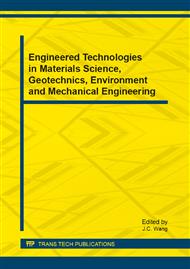[1]
Ruan Aiguo, Li Jiabiao, Chu Fengyou, et al. AVO numerical simulation of gas hydrates reflectors beneath seafloor. Chinese Journal of Geophysics (in Chinese), 2006, 49(6):1826~1835.
DOI: 10.1002/cjg2.994
Google Scholar
[2]
Hyndman R D, Spence G D. A seismic study of methane hydrate marine bottom simulating reflectors. J. Geophys. Res., 1992, 97:6683~6698.
DOI: 10.1029/92jb00234
Google Scholar
[3]
Wyllie M R J, Gregory, and Gardner G H F. An experimental investigation of factors affecting elastic wave velocities in porous media. Geophysics, 1958, 23:459~493.
DOI: 10.1190/1.1438493
Google Scholar
[4]
Pearson C F, Halleck P M, McGulre P L, et al. Natural gas hydrate; A review of in situ properties. J. Phys. Chem., 1983, 87:4180~4185.
DOI: 10.1021/j100244a041
Google Scholar
[5]
Nobes D C, Villinger H, Davis F F, et al. Estimation of marine sediment bulk physical properties at depth from seafloor geophysical measurements. J. Geophys. Res., 1986, 91: 14033~14043.
DOI: 10.1029/jb091ib14p14033
Google Scholar
[6]
Lee M W, Hutchinson D R, Collett T S, et al. Seismic velocities for hydrate-bearing sediments using weighted equation. J. Geophys. Res., 1996, 101:20347~20359.
DOI: 10.1029/96jb01886
Google Scholar
[7]
Biot M A. General theory of three-dimensional consolidation. J. Appl. Phys., 1941, 12: 155~164.
Google Scholar
[8]
Gassmann F. Elasticity of porous media, Vierteljahrsschrift der Naturforschenden Gesselschaft, 1951, 96:1~23
Google Scholar
[9]
Lee M W. Modified Biot-Gassmann theory for calculating elastic velocities for unconsolidated and consolidated sediments. Marine Geophysical Researches, 2002, 23:403~412.
DOI: 10.1023/b:mari.0000018195.75858.12
Google Scholar
[10]
Zillmer M. A method for determining gas- hydrate or free-gas saturation of porous media from seismic measurements. Geophysics, 2006, 71:21~32.
DOI: 10.1190/1.2192910
Google Scholar
[11]
Helgerud M B, Dvorkin J, Nur A, et al. Elastic-wave velocity in marine sediments with gas hydrate: Effective medium modeling. Geophysical Research Letters, 1999, 26:2021~2024.
DOI: 10.1029/1999gl900421
Google Scholar
[12]
Winters W J, Waite W F, Mason D H, et al. Sediment properties associated with gas hydrate formation. 4th International Conference on Gas Hydrate, 2002, 722~727.
Google Scholar
[13]
Winters W J, Waite W F, Mason D H, et al. Methane gas hydrate effect on sediment acoustic and strength properties. Journal of Petroleum Science and Engineering, 2007, 56:127~135.
DOI: 10.1016/j.petrol.2006.02.003
Google Scholar
[14]
Yun T. S., Francisca F. M., Santamarina J. C., et al. Compressional and shear wave velocities in uncemented sediment containing gas hydrate. Geophysical Research Letters, 2005, 32, L10609:1~5.
DOI: 10.1029/2005GL022607
Google Scholar
[15]
Yun T S, Narsilio G A, Santamarina J C, et al. Instrumented pressure testing chamber for characterizing sediment cores recovered at in situ hydrastatic pressure. Marine Geology, 2006, 229:285~293.
DOI: 10.1016/j.margeo.2006.03.012
Google Scholar
[16]
Yang J, Llamedo M, Marinakis D, et al. Successful application of a versatile ultrasonic test system for gas hydrates in unconsolidated sediments. 5th International Conference on Gas Hydrate, Trondheim, Norway, 2005, 340~346.
Google Scholar
[17]
Zhao Qun, Guo Jian, Hao Shouling, et al. Experiments of physical modeling for petrophysical properties of natural gas hydrate. Chinese Journal of Geophysics (in Chinese), 2005, 48(3):649~654.
DOI: 10.1002/cjg2.705
Google Scholar
[18]
Spangenberg E, Kulenkampff J. Physical properties of gas hydrate-bearing sediments. 5th International Conference on Gas Hydrate, Trondheim, Norway, 2005, 587~596.
Google Scholar
[19]
Priest J, Best A, Clayton C, et al. Seismic properties of methane gas hydrate-bearing sand. 5th International Conference on Gas Hydrate, Trondheim, Norway, 2005, 440~447.
DOI: 10.1029/2004jb003259
Google Scholar
[20]
Ye Yuguang, Zhang Jian, Diao Shaobo, et al. Geophysical simulating apparatus for gas hydrate detection. Chinese Patent: CN200410036544.X, 2004, p.10.
Google Scholar
[21]
Li Yalin, He Zhenhua, Huang Deji, et al. Relation between rock porosity-permeability property and seismic wave attenuation and propagation velocity (in Chinese). Natural gas industry, 2001, 21(4): 7~11.
Google Scholar
[22]
Sun Chunyan, Zhang Mingyu, Niu Binghua, et al. Micromodels of gas hydrate and their velocity estimation methods (in Chinese). Earth Science Frontiers (China University of Geosciences, Beijing), 2003, (10):191~198.
Google Scholar


